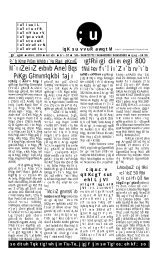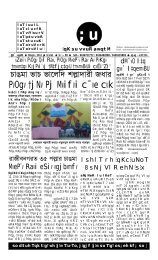You also want an ePaper? Increase the reach of your titles
YUMPU automatically turns print PDFs into web optimized ePapers that Google loves.
part of Secular India. A majority of Chakmas<br />
are bound to feel they are living under the<br />
mercy of the majority, not in a democracy!<br />
Just look at the way the then Sub Divisional<br />
Officer (Civil) of West Phaileng, Mr<br />
Sangthuama in a letter dated 24 May 2008<br />
threatened to cut off all welfare schemes and<br />
pro-poor programmes at Khantlang village<br />
in Mamit district if the village council did<br />
not allot land for a Church there. Or just<br />
admire the audacity of the Deputy Commissioner<br />
of Lunglei Ms M Zoohmingthangi<br />
who has threatened, with total absence of<br />
fear of the law, the Chakmas of Saisen,<br />
Bandiasora, Nekuksora, Debasora, Malsury<br />
and Tablabagh to vacate their villages which<br />
have fallen outside the India-Bangladesh<br />
border fence before 25th February <strong>2011</strong> or<br />
face brute action.<br />
The nineties saw large scale systematic<br />
attacks against Chakmas. Notably these<br />
were all visible to the naked eye - physical<br />
assaults, burning down of houses, attacks on<br />
Buddhist temples/statues, arbitrary deletion<br />
of citizens from voters list, denial of civil and<br />
political rights, etc. But those were the days<br />
in the past. With the change of times, the tactics<br />
at the hands of the rulers too changed.<br />
Mizoram perhaps learnt from Gujarat that<br />
open repression tactics like launching physical<br />
attacks against religious minorities won’t<br />
work in highly globalized environment with<br />
mobile phones in every body’s pockets,<br />
24x7 private television channels and when<br />
every citizen can be a “citizen journalist”.<br />
The subtleness of the repression against the<br />
Chakmas, therefore, had to change over the<br />
years, especially in the last a few years. The<br />
repression of today has become more subtle,<br />
more systematic and yet, less visible to the<br />
naked eye. Presently, the persecution is<br />
BB vIyUElt gIEsgIH<br />
<strong>2011</strong> BB<br />
more through denial of economic and social<br />
progress and less of physical atrocities.<br />
II. Three-layered strategy<br />
In my view, the Mizoram government<br />
has long ago adopted and continues<br />
to pursue a systematic “three-layered strategy”<br />
to suppress the Chakmas.<br />
First: deny basic education<br />
The fundamental of Mizoram’s<br />
policy is to keep the Chakmas illiterate and<br />
socio-economically backward. Once in every<br />
five year (or whenever necessary), the<br />
acute poverty helps the political leaders to<br />
win elections by paying a few thousand rupees<br />
to the village level leaders and just a<br />
few bundles of bidi and match boxes to the<br />
common voters during elections while ignoring<br />
them for the entire term. This way<br />
the political leaders and the state government<br />
can also serve their goals to deny fundamental<br />
right to have access to basic<br />
amenities to Chakmas. T h is<br />
is the reason why till today 72% of the<br />
Chakma villages do not have Middle<br />
Schools and 96% Chakma villages are without<br />
High Schools in Mizoram. More than<br />
half of the Chakmas are still illiterate, although<br />
Mizos have nearly touched cent per<br />
cent literacy mark.<br />
Second: choke the economic lifeline<br />
The Chakmas have succeeded to<br />
attain higher education in spite of the<br />
Mizoram government’s policies, not because<br />
of them. To make the record straight,<br />
most of the Chakma youths in the 1990s<br />
42 BB









